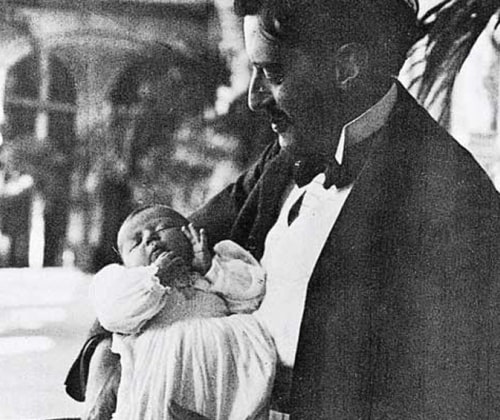
George W. Vanderbilt and The Ramble
A statue of George W. Vanderbilt greets all who enter Longmeadow Park, an emblematic reminder of the rich history of The Ramble. Without George W. Vanderbilt, The Ramble would not exist today, nor would its guiding principles of community, craftsmanship, and stewardship of the land.
In the late 1880s, weary of city life, George W. Vanderbilt went down to Western North Carolina to explore and cement his dedication to the budding practice of conservationism. After expressing his deep concerns over the practice of clear-cutting with pioneering landscape architect Frederick Law Olmsted and forestry expert Gifford Pinchot, Vanderbilt turned his attention to the land around his beautiful Biltmore Estate. He Purchased 100,000 acres of untouched property, including the area now known as The Ramble. Within this acreage, Vanderbilt began to put his theories into practice, allowing loggers to harvest trees only under strict conservation rules. Additionally, he planted white pines across this new property, including on top of Ducker Mountain. Many of these magnificent trees can be found in The Ramble today.

In the late 1800s, Vanderbilt enlisted Carl Alwin Schenck to become the chief forester of all Biltmore forests. Schenck shared in Vanderbilt’s vision as a conversationist, planting a variety of trees and building infrastructure to mitigate future erosion issues across the forests. In 1898, Scheneck and Vanderbilt created the first school of forestry, The Biltmore Forestry School. This novel school was situated in the heart of Pisgah Forest and focused on educating trainees in the science of forestry. Scheneck, upon a successful Biltmore Forest Fair, praised Vanderbilt, stating “If men held their peace, the trees would cry aloud: ‘Honor and thanks to you, George W Vanderbilt.’” Thousands of acres of wildlife, forests, and nature were protected in a time where industrialization ravaged landscapes across the United States. After Schenck moved on, Vanderbilt’s chief collaborator Frederick Law Olmsted, the inspiration behind much of The Ramble’s design, sent Chauncey Beadle to continue his work on Biltmore land. Beadle’s dedication to forestry was vital to furthering the principles of conservationism.

In 1911, Week’s Law, creating the National Forest system, was passed by Congress, enshrining the important of conservationists throughout the greater United States. At the end of his life, George W. Vanderbilt began divesting a significant portion of his vast wooded lands to the Department of Agriculture. Upon his untimely death, his widow, Edith Vanderbilt, finished this project, contributing to what became the center of Pisgah National Forest.
The Ramble’s history is unlike any other gated community in the country. Stemming from Vanderbilt’s passion and commitment to forestry and preservation, much of the land remains wooded and wild, allowing plants, wildlife, and native trees to thrive untouched. From the aquatic life in and around Dingle Creek to the majestic white pines planted over a millennium ago, The Ramble roots itself in the history and love for the land.